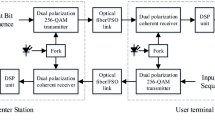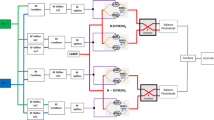Abstract
In this study, we report a cross gain modulation (XGM)-based Indium Phosphide (InP) photonic integrated wavelength conversion of 128 GBaud DP-16QAM signals in semiconductor optical amplifiers (SOAs). An Indium Phosphide photonic integrated circuit (InP-PIC) is most advanced platform for variety of applications including free space optical communications, microwave photonics, and LiDAR (light detection and ranging). The InP-PIC consists two cascaded Semiconductor optical amplifiers (SOAs), integrated band pass filter and a delay-line interferometer (DLI) filter to exploit double stage cross gain modulation (XGM). The wavelength converter is characterized at various power levels over a wide range of converted wavelengths. The system performance is analyzed using bit error rate (BER), Extinction ratio (ER), ON-OFF gain and conversion efficiency (CE). BER is measured over a received power range of -12 dBm to 4 dBm. At \( {\varvec{B}\varvec{E}\varvec{R}=10}^{-9}\), power penalties are lowered to less than 1 dB for down-converting signals and 2 dB for up-converting signals, respectively. A 12 dB gain in CE is achieved over a 60 nm frequency shift. Measured valued of ER are 15.2 dB, 14.5 dB, and 12.95 dB for back-to-back (b2b), down-conversion, and up-conversion at 128 GBaud (1 Tbps) spanning a wavelength range of 35 nm from 1525 nm to 1565 nm.











Similar content being viewed by others
Data Availability
Not applicable.
References
Yoo, S. J. B. (2022). Prospects and challenges of Photonic switching in Data centers and Computing systems. J Lightw Technol, 40(8), 2214–2243.
Mendinueta, J. M. D., Shinada, S., Hirota, Y., Furukawa, H., Wada, N., High-Capacity Super-Channel-Enabled Multi-Core Fiber Optical Switching System for Converged Inter/Intra Data Center and Edge Optical Networks, IEEE Journal of Selected Topics in Quantum Electronics, 26(4),
Kaur, H., Kaler, R. (2020), SOA-MZI based 4 × 4 interconnected crossbar photonic wavelength switching for datacenter load balancing, Optical Engineering, 59(11), 117109,
Raja, A. S., Lange, S., Karpov, M., Shi, K., Fu, X., Behrendt, R., Cletheroe, D., Lukashchuk, A., Haller, I., Karinou, F., Thomsen, B., Jozwik, K., Liu, J., Costa, P., Kippenberg, T. J., & Ballani, H. (2021). Ultrafast optical circuit switching for data centers using integrated soliton microcombs, Nature Communications, 12, 5867.
Parashuram, C., Kumar, (2022). Suppression of Four Wave Mixing Effects Under Different Spectrally Efficient Modulation Techniques in Hybrid DWDM-OTDM Systems, Indian Journal of Pure and Applied Physics (IJPAP), 60, 8.
Wei, W., Li, Q., Wang, Y., & Duan, J. Erbium-doped fiber laser with switchable wavelength generation based on tunable filter and dual-pass mach-zehnder filter incorporated with fiber delay line, 97(8), Physica Scripta, 2022.
Akiyama, T., Kuwatsuka, H., Hatori, N., Nakata, Y., Ebe, H., & Sugawara, M. (2002). Symmetric highly efficient wavelength conversion based on four-wave mixing in quantum dot optical amplifiers. IEEE Photon Technol Lett, 14, 1139–1141.
Otsubo, K., Akiyama, T., Kuwatsuka, H., Hatori, N., Ebe, H., & Sugawara, M. (2005). Automatically controlled C-band wavelength conversion with constant output power based on four-wave mixing in SOAs. IEICE Trans Electron, E88-C, 2358–2365.
Said, Y., Rezig, H., & Bouallegue, A. (2010). Performance evaluation of Wavelength Conversion using a Wideband Semiconductor Optical Amplifier at 40 Gbit/s. The Open Optics Journal, 4, 21–28.
Contestabile, G., et al. (Dec., 2010). Cross-gain Modulation in Quantum-dot SOA at 1550 nm. IEEE.
Winzer, P. J., Gnauck, A. H., Doerr, C. R., Magarini, M., & Buhl, L. L. (2010). Spectrally efficient long-Haul Optical networking using 112-Gb/s polarization-multiplexed 16-QAM. Journal of Lightwave Technology, 28, 4.
Richter, T., Elschner, R., Gandhe, A., Petermann, K., & Schubert, C. (2012). Parametric Amplification and Wavelength Conversion of single- and dual-polarization DQPSK signals. IEEE Journal of Selected Topics in Quantum Electronics, 18, 2.
Hu, H., Jopson, R. M., Gnauck, A. H., Dinu, M., Chandrasekhar, S., Xie, C., & Randel, S. (2015). Parametric amplification wavelength conversion and phase conjugation of a 2.048- Tbit/s WDM PDM 16-QAM signal. Journal of Lightwave Technology, 33, 1286–1291.
Lu, J., Yu, J., Zhou, H., Li, Y., & Chen, L. (2011). Polarization insensitive wavelength conversion based on dual-pump four-wave mixing for polarization multiplexing signal in SOA. Optics Communications, 284, 5364–5371.
Elschner, R., Bunge, C. A., i Coca, A. G., Schmidt-Langhorst, C., Ludwig, R., Schubert, C., & Petermann, K. (2008). Impact of pump-phase modulation on FWM-based wavelength conversion of D(Q)PSK signals. IEEE Journal of Selected Topics in Quantum Electronics, 14, 3.
Hsu, D. Z., Lee, S. L., Gong, P. M., Lin, Y. M., Lee, S. S. W., & Yuang, M. C. (2004). High-efficiency wide-Band SOA-Based Wavelength converters by using dual-pumped four-Wave Mixing and an Assist Beam. IEEE Photon Technol Lett, 16, 8.
Fillion, B., Ng, W. C., Nguyen, A. T., Rusch, L. A., & LaRochelle, S. (2013). Wideband wavelength conversion of 16 Gbaud 16-QAM and 5 Gbaud 64-QAM signals in a semiconductor optical amplifier. Optics Express, 21(17), 19825–19833.
Mahad, F. D., Supa’at, A. S. M., Idrus, S. M., & Forsyth, D. (2013). Analysis of Semoconductor Optical Amplifier (SOA) Four Wave Mixing (FWM) for future all optical wavelength conversion. Optik- Int J Light and Electron Optics, 124(1), 1–3.
Contestabile, G., Calabretta, N., & Ciaramella, E. (2006). Double-stage Cross-gain Modulation in SOAs: An effective technique for WDM Multicasting. IEEE Photonics Technology Letters, 18, 1.
Kong, X., & Zhao, Y. (2021). All optical wavelength conversion of dual users CO-OFDM system based on FWM in cascade HNLFs. Optical Fiber Technology, 63, 102480.
Lu, G. W., Sakamoto, T., & Kawanishi, T. (2014). Wavelength conversion of optical 64QAM through FWM in HNLF and its performance optimization by constellation monitoring. Optics Express 22 (1).
Takasaka, S., & Takahashi, M. (2010). Polarization insensitive arbitrary wavelength conversion in entire C-band using a PM-HNLF, in Proc. 36th Eur. Conf. Opt. Commun., Turin, Italy, Paper Th.9.C.2.
Mirza, J., Kanwal, B., & Ghafoor, S. (2020). Microwave photonic notch filter based on polarisation multiplexing and cross gain modulation in a semiconductor optical amplifier, 56(4), 189–192.
Bontempi, F., Faralli, S., Andriolli, N., & Contestabile, G. (2013). An InP Monolithically Integrated Unicast and Multicast Wavelength Converter. IEEE Photon Technol Lett, 25, 2178–2181.
Ishikawa, H. (2008). Ultrafast all optical signal processing devices. Wiley.
Smit, M., et al. (2014). An introduction to InP-based generic integration technology. Semiconductor Science and Technology, 29(8), Art083001.
Sobhanan, A., Anthur, A., O’Duill, S., Pelusi, M., Namiki, S., Barry, L., Venkitesh, D., & Agrawal, G. P. (2022). Semiconductor optical amplifiers: Recent advances and applications. Advances in Optics and Photonics, 14, 3, 571–651.
Shi, B., Calabretta, N., & Stabile, R. (2022). Emulation and modelling of semiconductor optical amplifier-based all-optical photonic integrated deep neural network with arbitrary depth. Neuromorphic Computing and Engineering, 2, 3.
Funding
No financial funding for this work.
Author information
Authors and Affiliations
Contributions
All authors contributed to simulation, concept, writing, and review.
Corresponding author
Ethics declarations
Ethical Approval
Not applicable.
Confict of Interest
The authors declare that they have no confict of interest.
Additional information
Publisher’s Note
Springer Nature remains neutral with regard to jurisdictional claims in published maps and institutional affiliations.
Rights and permissions
Springer Nature or its licensor (e.g. a society or other partner) holds exclusive rights to this article under a publishing agreement with the author(s) or other rightsholder(s); author self-archiving of the accepted manuscript version of this article is solely governed by the terms of such publishing agreement and applicable law.
About this article
Cite this article
Parashuram, Kumar, C. InP Photonic Integrated All-Optical Wavelength Conversion of 128 GBaud DP-16QAM Signals Using XGM in SOAs. Wireless Pers Commun 135, 1519–1538 (2024). https://doi.org/10.1007/s11277-024-11121-3
Accepted:
Published:
Issue Date:
DOI: https://doi.org/10.1007/s11277-024-11121-3




